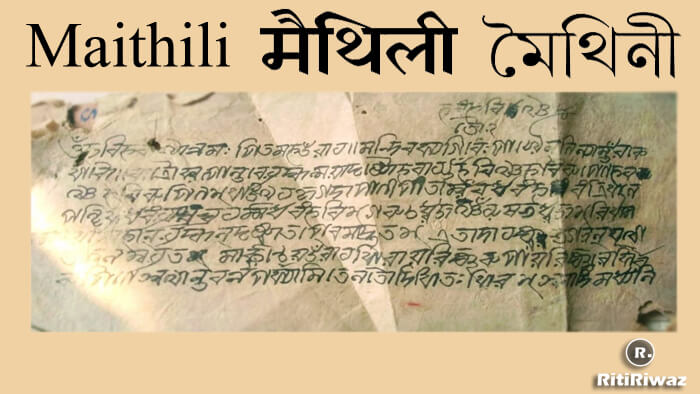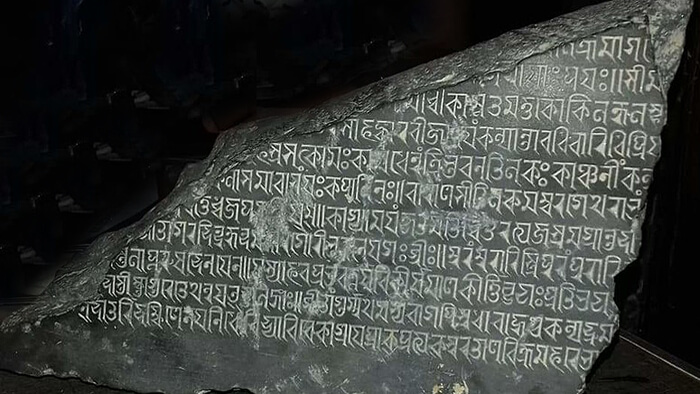Maithili Language

Maithili मैथिली, মৈথিলী also known as Bihari, Tirhutia, Methli is one of the main languages of Bihar state. It is also spoken in the Jharkhand and Terai region of southern Nepal. Maithili is an Indo-Aryan language of the Indo-European language family.
It is spoken in Eastern Bihar and is closely related to Bhojpuri and Magahi and is the only language of Bihari with a script of its own. It is one of the 22 recognized Indian languages and also the second most used language in Nepal (one of the 122 recognized Nepalese languages).
History

Maithili is a living language and has a glorious history of its own. The term Maithili comes from Mithila, which was an independent state in ancient times, the ancient kingdom ruled by King Janaka (refer to Ramayana).
Its history is the history of the growth of one of the earliest important languages of northeastern India. That influenced in one way or the other, all the languages of eastern India. Maithili is the language of the Mithila people who lived on the north by the Himalayas and on the South, west, and east by the Ganges, Gandaka, and the Kaushiki respectively. The region forms part of the north-eastern part of Bihar.
Maithili seems to have emerged in the neighborhood of tenth-eleventh century A.D. and has passed through successive stages of development known as old, middle, and modern (Maithili).
(i) Proto-Maithili (8th -11th c. AD) (ii) Early Maithili (12th -16th c. AD) (iii) Middle Maithili (17th – 18th c. AD) (iv) Modern Maithili (18th c. AD onwards)Maithili has a long tradition of at least seven hundred years, being on center stage in the whole of north-eastern India including Nepal. Mithilakshar or Tirhuta is the script of broader cultural Mithila that emerged during the 10th Century AD and the oldest script is found in Sahodara stone inscriptions of 950 AD. Maithili was popularised in the fourteenth century by poet Vidyapati and solidified the importance of the language in literature.
Early Maithili literature (c. 700-1350 AD) comprised ballads, songs, and dohas. Sarahapad (700-780 AD), Chandramani Datta whose Mithila Bhasha Ramayana and Mahabharata have been found written completely in Mithilakshara, Umapati, and Shankaradattan are noted literary figures.
Middle Maithili Literature (c. 1350-1830 AD) was dominated by theatrical writings, Maithili writers who dominated being Vidyapati, Srimanta Sankardeva, Govindadas, Vishnupuri, Kamsanarayan, Mahesh Thakur, Karn Jayanand, Kanharamadas, Nandipati, Lalkavi, Manabodha, Sahebramadas, Buddhilal, and Ratnapani.
The most famous literary figure in Maithili is the poet Vidyapati (1350-1450), who heralded the trend of writing in Maithili. He produced over a thousand immortal songs in Maithili on the theme of erotic sports of Radha and Krishna and the domestic life of Shiva and Parvati as well as on the subject of the suffering of migrant laborers of Morang and their families; besides he wrote a number of treatises in Sanskrit.
Modern Maithili no longer plays a subservient role to Sanskrit and this is an indication of the vitality it has acquired in modern times. Modern Maithili has many idioms, turns, and twists of expression which have been undoubtedly introduced by the thought pattern of the English language. Modern Maithili has two distinct literary styles viz. Shishtabhasha (sadhu-bhasha) (elegant language) and Chalitabhasha (current language).
Even after the Muslim conquest, when Sanskrit ceased to be a living language in a greater part of India, Mithila continued to cultivate it with all earnestness. Sanskrit provided Maithili with a great intellectual and spiritual background. Sanskrit however also provides a hindrance to the growth of Maithili. Maithili literature found room to grow in the gap left by Sanskrit after Sanskrit had become difficult for the common man.
Maithili is one of the oldest languages of India and its influence on contemporary languages is immense. The regular contact between Maithili, Nepal, Assam, Bengal, and Orissa in the middle age was responsible for the propagation of this language in different parts. The impact of the Maithili language was so great that even a poet of the eminence of Rabindranath Tagore was attracted to Maithili composed Bhanusimha Thakurer Padavali in Maithili which was the main vehicle of the common culture of the whole of eastern India in those days.
The Maithili language has been accorded Constitutional status in 2003 and it became one of the 22 languages mentioned in the 8th Schedule of the Constitution, which allows the language to be used in education, government, and other official contexts.
Suggested Read: Bihar Culture and Tradition
Maithili Scripts
Maithili is written in four scripts: (i) Tirhuta or Mithilakshari (ii) Neware (iii) Kaithi (iv) NagariThe Tirhuta/Tirhutia or Mithilakshari is the indigenous script of Maithili. However, Devanagari is now used as the common standard script for the language and has also been recognized as the script associated in the 8th schedule of the Indian constitution. An effort is underway to preserve the Maithili script and to develop it for use in digital media by encoding the script in the Unicode standard.
Maithili dialects
Maithili is considered a dialect of Bihari Languages. It varies greatly in dialects. Bajjika, Central, Angika, Thethi, and Tharuwat (spoken exclusively in Nepal) are the major dialects of Maithili. The standard form of Maithili is Sotipura or Central Maithili or Madhubani dialect mainly spoken in Darbhanga and Madhubani districts in Bihar.
Bajjika dialect of Maithili is spoken in Samastipur, Sitamarhi, Muzaffarpur, Vaishali, East Champaran, and West Champaran districts of Bihar in India. Bajjika is listed as a distinct language in Nepal and overlaps by 76–86% with Maithili dialects spoken in Dhanusa, Morang, Saptari, and Sarlahi districts.
Thethi dialect or Mungeri dialect is spoken in the parts of Munger division lying on the south of the Ganga River.
Another minor dialect, Jolaha Maithili is a variance of the Maithili language usually spoken by Muslims of Mithila. It has no specific region. Its distribution depends on the distribution of the Muslim population in the region.
Angika of Bhagalpur Division in Bihar and Santhal Pargana division in Jharkhand is sometimes considered another, rather than a separate language.
